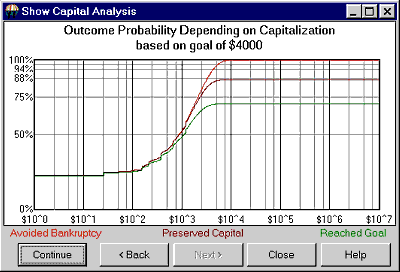(Excerpted From the February, 2000 CSI Technical Journal)
In recent months we have devoted much attention to the way Unfair Advantage's Trading System Performance Evaluator certifies analysis results and assesses capital requirements in terms of probability values. As is often the case with innovative products, every bit of new information we supply brings more thoughtful questions from our customers. Several TSPE users have asked for tips on setting appropriate goals and interpreting results. We hope the following information helps.
Engaging TSPE in an attempt to quantify your required capital stake commensurate with your suggested goal requires that you supply TSPE with a real or simulated record of profits and losses observed over time. After entering that string of performance numbers, you will be asked for your parameter count, profit goal and a realistic setting for the number of trades you are willing to make to achieve your goal.
Choosing a Goal
The choice of goal is an important input for any TSPE analysis. The user should attempt to identify a goal commensurate with expected investment risk. TSPE can readily compute required investment capital (the horizontal capitalization axis on the TSPE display chart), but it cannot simulate a market trading program without knowing what would be a reasonable dollar objective or goal. It could take a couple of simulated trading exercises with TSPE to refine the targeted goal.
Just about any investor knows what might be earned without any appreciable risk by simply visiting a local bank or examining published CD rates. Of course such a pursuit should take into account discounted losses due to real dollar inflation. Perhaps such an exercise should be a basic starting point in determining a reasonable goal. The specified goal should provide for a handsome return that will exceed nominal bank rates by some substantial multiple of bank rates less the economy's rate of inflation. Keep in mind that the probability of recovering invested capital plus goal (the vertical scale on the TSPE display chart) should be as close to certainty as possible to undertake the planned investment.
Another consideration related to the setting of a goal is the number of trades one might be willing to tolerate before taking capital from the market. This latter constraint has an elapsed time value that should be understood before entering the market. A trading system becomes profitable in practice when a given goal is achieved. The likelihood that a goal will be met depends upon the dollar level of the goal and the time it takes to persist in trading when marginal performance develops over time. Marginal performance will readily occur in any profitable system when profits and losses statistically alternate, prolonging the attainment of the ultimate targeted goal. In TSPE, the difference between the probability of preserving one's capital (the center curve in the Capitalization chart) and the probability of certain goal achievement is the difference between 1.0 and the horizontal center curve for high levels of invested capital. This difference, for purposes of explanation, is known as the Probability of Marginal Performance. Choosing a very large, but unreasonable "Number of Trades" will force all scenarios for a winning system to approach 1.0, given that infinite capital is available and the Probability of Marginal Performance is zero.

If the Probability of Marginal Performance is, say 2% for a given level of invested capital, this means that 2% of the time profits were not elevated sufficiently beyond the invested capital to achieve your goal. It does not mean that you lost an additional 2% of the time. It simply means that you did not achieve your goal. This is so because your invested capital remained intact. The TSPE user should understand that there will be occasions where capital is preserved, yet capital remains in place a finite percentage of the time.